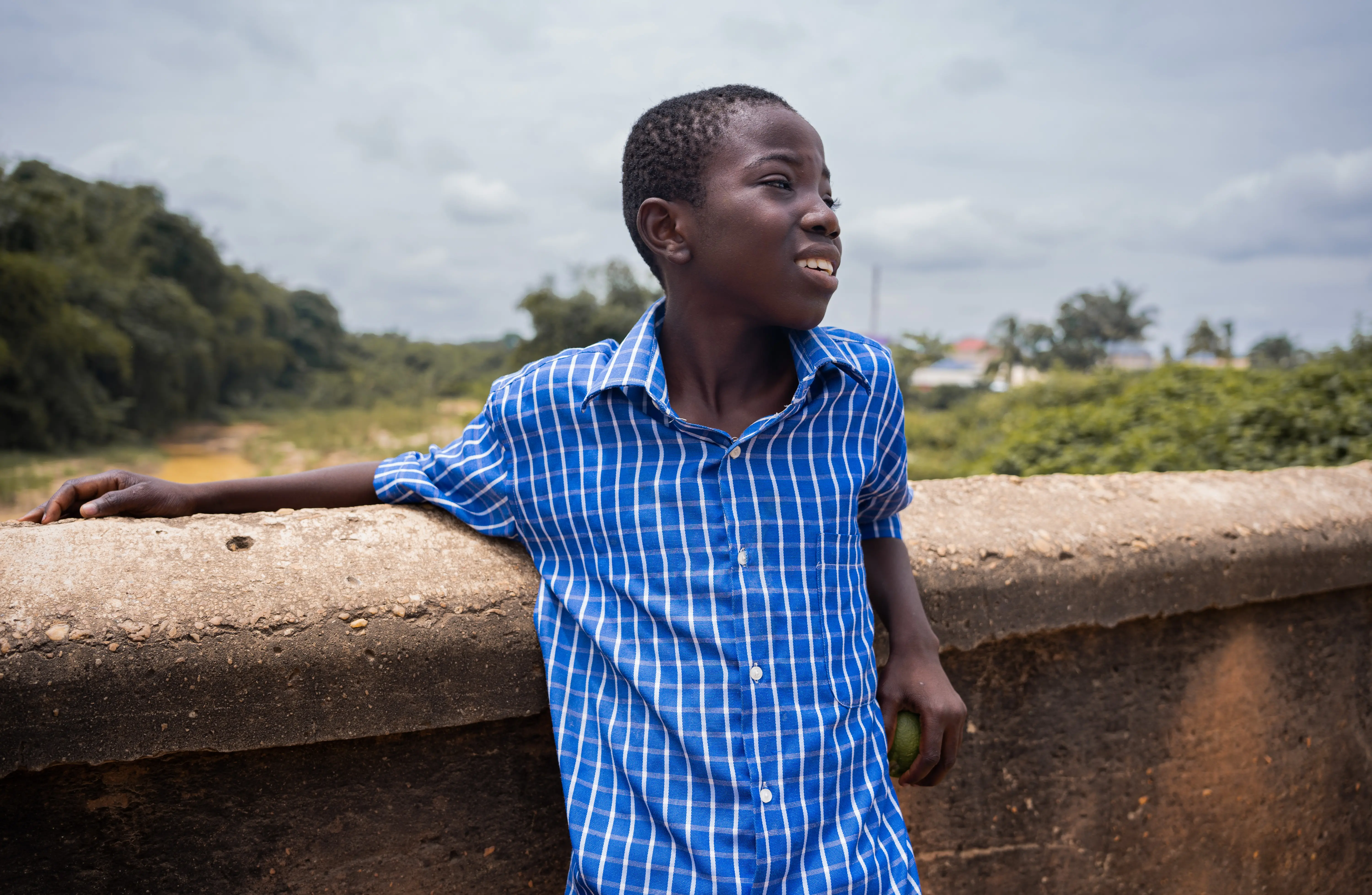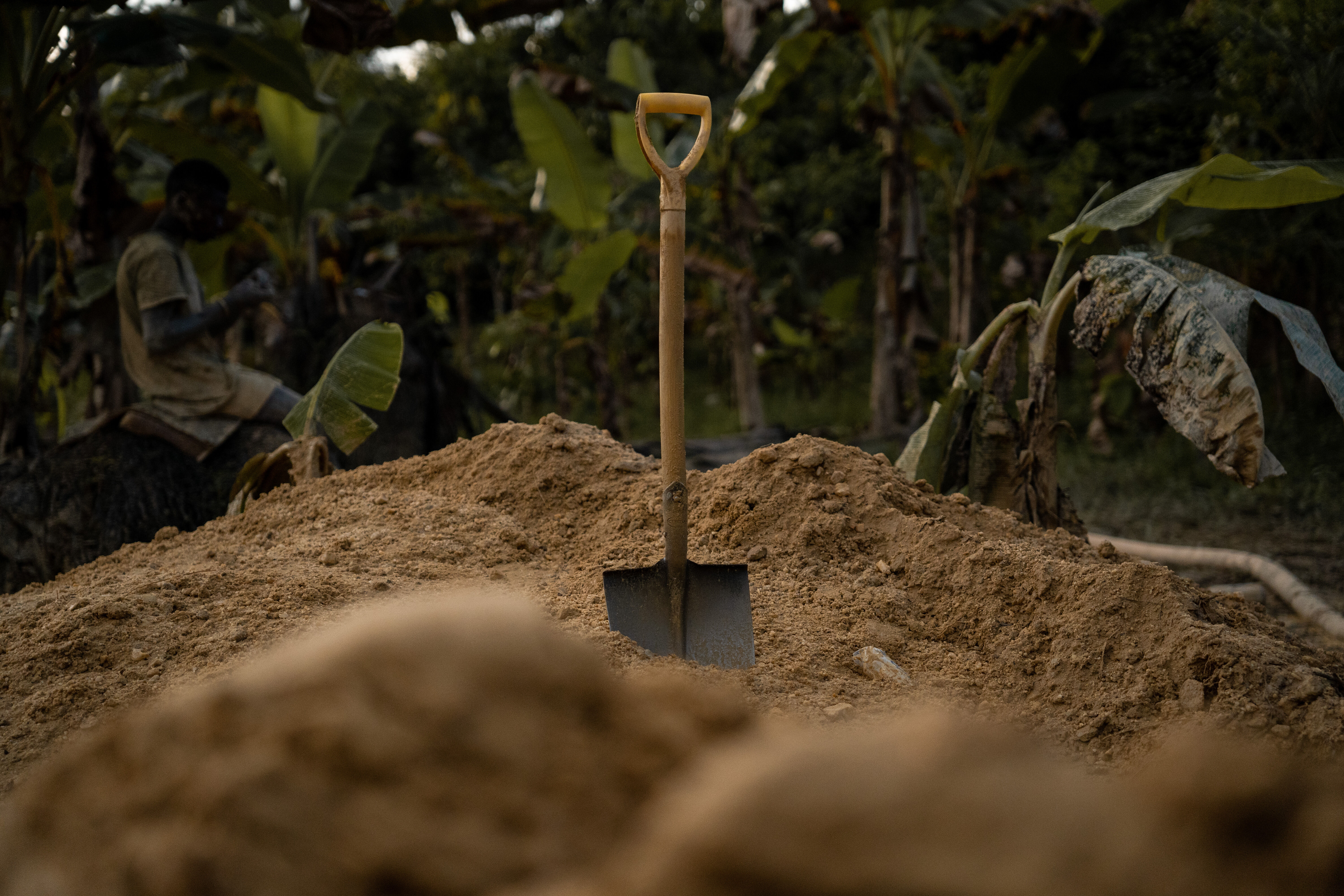
At age 11, Lewandowski Coffie dreams of becoming a professional footballer. But he has no game reels, no team, not even a ball.
He lives in the mining community of Wassa Akropong, a dust-filled city in the southwest of Ghana that sits upon one of the biggest deposits of gold in the world. Despite that, 23% of Ghana’s population live below the national poverty line—existing on the equivalent of $68 a month. Many dream of getting rich by tapping into the deposits often without a license. Known as galamsey, these small operations are illegal, unregulated, and the source of livelihood for more than 10% of the population.

The operations are also an environmental threat. Since gold fever hit the region in the early 2010s, major sources of drinking water have become contaminated with chemicals and heavy metals used by small-scale and illegal miners, said CSIR-Water Research Institute Director Mike Y. Osei-Atweneboana. Erosion has left areas unproductive for farming and at risk for flooding. The small lake pits where people seek gold are hazards, especially to children.
The water in the river closest to Coffie’s village, the gold-bearing Ankobra—is unsafe to drink. Mercury and total cyanide levels exceed those represented on the WHO Guidelines for drinking-water quality, a sample revealed Aug. 3, 2022.

Although he’s just 11, Coffie is wary of the mining activities: “Galamsey is only for fast money,” he tells Nana, the foreman of a galamsey operation outside of Wassa Akropong.
Coffie’s button-down shirt, suede slacks and perfect smile belie the fact that he can’t afford to pay his $5 school fee. Without the money, he won’t be eligible to play football.
Standing on a bridge overlooking a large stream that runs alongside his village, he talks about the effects of mining, including seeing children fall into the polluted water while playing football. “Galamsey isn’t necessary,” he said. “It hurts the environment. My cousins mine, but don’t share with me.”
Blessing and Curse
In 2016, Kwabena lived in a mud hut that flooded when it rained. A high school dropout, Kwabena sold firewood for 20 Ghana cedis ($2). He was 22 when he realized he could make more in illegal mining.
“I once saw the galamsey process in my neighborhood when I was out collecting firewood for sale,” he said. “A woman called me to the site to help with moving sand. I did as she asked and helped to move the sand. Later on that day, she brought me 100 cedis ($10) from the sale of the gold she had extracted from the dirt, which was a portion of her earnings.”
Kwabena started as a checker, next-in-command to a Chinese supervisor in charge of the galamsey. He earned about 1,000 to 1,500 cedis ($100 to $150) per week.
Four years later, he started his own operation, buying cheap mining equipment from Indian immigrants and salvaging abandoned Chinese machinery following a military crackdown of Chinese galamseyers. After accounting for the cost of renting equipment, Kwabena took home an average profit of $1,500 per week—more money than he had ever seen in his life.
Kwabena pointed to his previous home: a pile of wet logs. The remnants of pits dredged for gold and filled with dirt leave his backyard pockmarked to this day. A two-story home—the reward for his work—now stands behind him, a symbol of the ‘Ghanaian dream.’ “I constructed this home using money I made from galamsey, and I also own some property,” Kwabena said.


Kwabena paid for the schooling of two of his siblings, invested in cocoa farming and helped one of his siblings receive training to operate an excavator. Beyond that, the wealth he shared made him a respected member within Wassa Akropong. Outside mining communities, many criticize galamsey.
Wassa Akropong is called “China Town” in Ghana by popular media because of the droves of foreign migrants who came there hoping to strike it rich. Foreign influence brought exposure specifically to the Ashanti gold belt. Discovery Channel even paid two foreigners from the United States to spearhead a galamsey operation in 2012.
In large part because of gold fever, Wassa Akropong grew more than 7% every year from 2010 to 2020. Somewhere along the way, galamsey became an all-but-necessary cog in its economy.
“This area, unlike Accra or Kumasi, [where] you can get anything you need; this place they depend solely on galamsey,” said Agada Køaicoe, a shoe and cosmetics trader in Wassa Akropong.
In 2018, Wassa Akropong became a hotspot for Ghanaian journalists. Police and armed forces followed suit, cracking down on galamsey operations in the area in a publicized effort. It was reported the Western Region accounted for 70% of illegal miner arrests that year.

Wassa Akropong still harbors galamsey, but many in the community report seeing less than the early days. Not all locals are thankful for these changes.
Køaicoe said her sales fell by half after the crackdowns.
“When I came here five years ago, galamsey was moving,” she said. “People were buying—buying! You could even count the money when you sleep. But now, it’s not like before [...] they have not allowed galamsey like that.”
But the miners—for the most part—haven’t disappeared or been arrested or started new jobs. Many simply moved to different towns where they can find better opportunities and continue to operate in clear sight. Today, galamsey has spread evenly across 13 of Ghana’s 16 regions.
(Kwabena and Nana's last names have been omitted to protect their privacy.)















